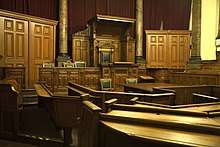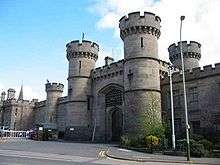National Justice Museum
|
The Galleries of Justice Museum exterior 2010 | |
| Former name | Galleries of Justice Museum |
|---|---|
| Established | 1995 |
| Location | The Lace Market, Nottingham |
| Collection size | HM Prison Service collection |
| Director | Victoria Reeves |
| Public transit access | Bus, tram, train |
| Website |
www |
The National Justice Museum (formerly the Galleries of Justice Museum and historically known as the Shire Hall and County Gaol), is an independent museum on High Pavement in the Lace Market area of Nottingham, England. The museum is housed in what was once a Victorian courtroom, gaol and police station, and is therefore a historic site where an individual could be arrested, sentenced and executed.
The courtrooms date back to the 14th century and the gaol to at least 1449. The building was used as a police station from 1905 to 1985, and the courts closed in 1986.
The museum is a registered charity.[1]
History
The National Justice Museum is housed in the former Shire Hall, which stands in the Lace Market area of Nottingham.
Early history
The earliest confirmed use of the site for official purposes was by the Normans, who appointed sheriffs to keep the peace and collect taxes; hence the site was also referred to as the Sheriff's Hall, the County Hall or the King's Hall. The first written record of the site being used as a law court dates from 1375. The first written reference to its use as a prison is in 1449.[2]
Eighteenth century
Over the centuries the courts and prison were developed and enlarged. In 1724 the courtroom floor collapsed. The Nottingham Courant in March 1724 recorded:[2]
On Monday morning, after the Judge had gone into the County Hall, and a great crowd of people being there, a tracing or two that supported the floor broke and fell in and several people fell in with it, about three yards into the cellar underneath. Some were bruised, but one man named Fellingham was pretty much hurt, one leg being stript to the bone, and was much hurt. This caused great consternation in Court, some apprehending the Hall might fall, others crying out "Fire!" etc. which made several people climb out of the windows. The Judge, being also terribly frightened, cried out "A plot! A plot!", but the consternation soon being over the Court proceeded to business.
The Hall was rebuilt between 1769 and 1772. The architect was James Gandon from London, and the cost about £2,500 (equivalent to £343,455 in 2016).[3] The builder was Joseph Pickford of Derby. The inscription on the top of the building reads:
This County Hall was erected in the year MDCCLXX and in the tenth year of the reign of His Majesty George III.
The building was fronted by an iron palisade to help control unruly crowds on the occasion of a public hanging.

Nineteenth century
Additional wings were added between 1820 and 1840. Changes were made to the nisi prius court in 1833. The judges' retiring room, barristers' robing room and office for a clerk were added in 1844.[4]
A new grand jury room was added in 1859 to designs by the architect Richard Charles Sutton.[4] Until 1832 most Nottingham hangings took place at Gallows Hill, but in 1832 they transferred to the Shire Hall. The last public execution was held in 1864 when Richard Thomas Parker was hanged. Executions were held on a scaffold erected over the stone steps in front of the central doorway, within the small enclosure created by closing the gates of the iron railings. The drop was described as approximately level with the lintel of the door. Three small square stone insets in the steps today are, in local legend, the sockets where the "Three-legged Mare" scaffold feet were set, but this design of scaffold was never used at Nottingham, and the steps themselves post-date the 1876 fire and public hangings. After the abolition of public executions in 1868 most hangings took place at the Borough Gaol, but on 21 November 1877 Thomas Gray was hanged in a yard at the rear of the Shire Hall. Despite common belief, the execution did not take place in the large rectangular yard seen today, but in a small yard ("Yard No.5") then existing on the west end of the site, now occupied by later building. A 9 feet deep pit was dug into the floor of the yard, thus removing the need for a scaffold, the uprights and cross beam from the old gallows being erected at ground level, with a trapdoor covering the pit and a tarpaulin over the structure to shield it from the nearby buildings on High Pavement.
In 1876 major improvements were made and the front was redesigned in a style described as Italianate by William Bliss Sanders of Nottingham. Within a few weeks a fire broke out and nearly destroyed all of the newly completed work.[5] Following the fire, the courts were largely rebuilt by Thomas Chambers Hine between 1876 and 1879. However, the gaol was closed in 1878.[4]
Twentieth/twenty-first centuries
A police station was added beside the building in 1905. The Shire Hall continued in use as Nottingham's civil and criminal courts until 1991, when Nottingham Crown Court was opened at Canal Street.
The Galleries of Justice Museum opened in the building in 1995. It was refurbished and rebranded as the National Justice Museum in 2017. The building houses two courtrooms, the underground jail and a site used for executions.
Exhibitions
The Crime Gallery includes a range of family activities, interactives and exhibitions exploring a range of topics relating to crime. This area also includes the dock from Bow Street Magistrates' Court.
References
- ↑ "1030554". Charity Commission. Retrieved 26 April 2012.
- 1 2 Brand, Ken. The Shire Hall and Old County Gaol Nottingham p.1. Nottingham Civic Society. ISBN 0950486132.
- ↑ UK Retail Price Index inflation figures are based on data from Clark, Gregory (2017). "The Annual RPI and Average Earnings for Britain, 1209 to Present (New Series)". MeasuringWorth. Retrieved 6 November 2017.
- 1 2 3 Ordering law: the architectural and social history of the English law court. Clare Graham
- ↑ Nottingham Daily Express, 4 December 1876.
External links
| Wikimedia Commons has media related to National Justice Museum. |

